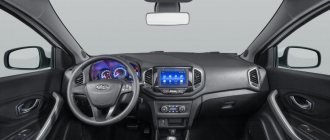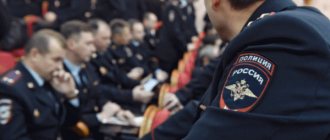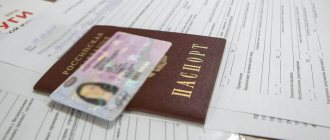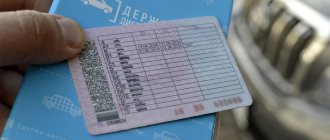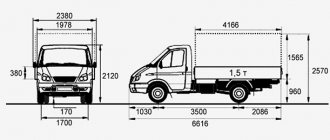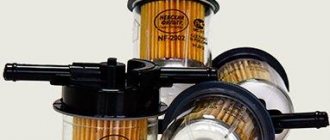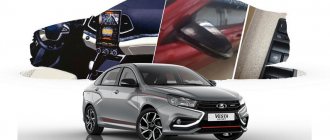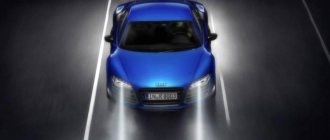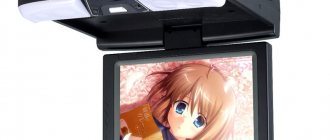Rules for measuring tinting
Every day hundreds or even thousands of drivers are held accountable under clause 3.1 of Art. 12.5 of the Code of Administrative Offenses of the Russian Federation for the use of tinted glass. How legal are the actions of traffic police officers who measure light transmission when stopping outside a stationary post, what should be the conditions for such a correct measurement: air temperature and humidity, and who is authorized to check?
How and on what basis is tinting checked?
Responsibility for the use of color films on the front and windshields with a decrease in the level of light transmission is established by Part 3.1 of Art. 12.5 Code of Administrative Offenses of the Russian Federation. The essence of the offense is driving a vehicle with glass installed that does not comply with technical regulations. At the same time, the law specifies that this violation also applies to colored films on glass, and, more simply, to any tinting.
Technical regulation 018/2011, namely clause 4.3, sets the minimum threshold for light transmission of tinting at 70%. This restriction applies to the windshield and front windows, which provide the driver with visibility when driving. There are also additional restrictions on the use of light-protective strips in the upper part of the glass. But now we are only interested in the light transmission of windows in general and the rules for measuring it in 2020.
Please note that the Regulations do not use any references to GOST. The previously valid GOST 5727-88, on the basis of which traffic police officers checked the light transmission of glass, became invalid on January 1, 2020 due to the adoption of GOST 32565-2013. Clause 4.7.3 GOST R 51709-2001 and clause 5.7.1 GOST R51709-2001, which motorists like to refer to when appealing the actions of a traffic police officer, copying complaints from the Internet, are also not valid as of 2020.
Clause 7.3 of the List of Malfunctions and Conditions from the Traffic Regulations prohibits the operation of vehicles with the installation of additional items or coating that limit visibility from the driver’s seat. This applies to both tinting in the form of a film and various removable structures - removable tinting, “curtains” and other coverings that limit the driver’s view.
Rules for measuring tint according to GOST: what conditions, weather and device should be?
Aug 24 2020 | Reading time: Rules for measuring tint Open content Every day hundreds or even thousands of drivers are held accountable under clause.
3.1 Art. 12.5 Code of Administrative Offenses of the Russian Federation for the use of .
How legal are the actions of traffic police officers who measure light transmission when stopping outside a stationary post, what should be the conditions for such a correct measurement: air temperature and humidity, and who is authorized to check? Responsibility for the use of color films on the front and windshields with a decrease in the level of light transmission.
The essence of the offense is driving a vehicle with glass installed that does not comply with technical regulations. At the same time, the law specifies that this violation also applies to colored films on glass, and, more simply, to any tinting. Technical regulation 018/2011, namely clause.
4.3 the minimum threshold for light transmission of tinting is 70%. This restriction applies to the windshield and front windows, which provide the driver with visibility when driving. There are also additional restrictions on the use of light-protective strips in the upper part of the glass.
But now we are only interested in the light transmission of windows in general and the rules for measuring it in 2020.
Please note that the Regulations do not use any references to GOST. The previously valid GOST 5727-88, on the basis of which traffic police officers checked the light transmission of glass, became invalid on January 1, 2020 due to the adoption of GOST 32565-2013. Clause 4.7.3 GOST R 51709-2001 and clause 5.7.1 GOST R51709-2001, which motorists like to refer to when appealing the actions of a traffic police officer, copying complaints from the Internet, are also not valid as of 2020.
How is tint measured according to the rules?
The mandatory use of special technical means to check the light transmission of glass is established in Art. 26.8 of the Code of Administrative Offenses of the Russian Federation, which reveals the concept of special technical means and specifies that the data obtained with their help must be reflected in the protocol.
The State Register of Measuring Instruments can be found on the Rosstandart website and you can find in the register the following light measuring instruments with a certificate valid as of 2020:
- a device for measuring tinting according to all the rules Tonic (registry No. 44919-10);
- Blik-N (registry No. 35807-07);
- Light (No. 20761-11);
The Register also contains other devices, but at the moment they do not have valid certificates of inclusion in the Register.
Rules for measuring tinting according to GOST
Rules for measuring tint according to GOST: what should be the conditions, weather and device? More than 50% of passenger cars on Russian roads have tinted windows. Therefore, every day and hourly drivers are held accountable under Art. 12.5 Code of Administrative Offences. Traffic police inspectors, when measuring the light transmittance of car windows, use special equipment.
What does the law say about tinted glass measurements?
According to the Technical Regulations in force in the Russian Federation, car windows must transmit more than 70% of sunlight. This is true for the front side and windshield. According to the rules, you cannot operate cars that have additional coatings installed or applied that interfere with the driver’s visibility.
Dear readers! Our articles talk about ways to resolve legal issues, but each case is unique. If you want to find out how to solve your particular problem, please use the online consultant form on the right or call. It's fast and free!
This directly applies to tinting or various removable coverings and materials: curtains, etc.
How are tinted glass measurements taken?
The traffic police inspector does not have the right to determine the light transmittance of car windows “by eye”. Therefore, in Art. 26.8 of the Code of Administrative Offenses stipulates what technical instruments should be used to carry out measurements and how the measurement results should be reflected in the protocol.
As of 2018, traffic police inspectors can use
the following equipment to measure the light transmittance of car windows:
- "Tonic" (No. 44919-10).
- "Light" (No. 20761-11).
- "Blik-N" (No. 35807-07).
Under what conditions should measurements be taken?
Contrary to popular belief, at the moment the Technical Regulations and current GOSTs do not regulate the rules for measuring the light transmittance of automobile windows.
Measurements can be made in any conditions, regardless of the surrounding air humidity, temperature, pressure and weather in general. GOST 32565-2013 specifies only general requirements for automobile glass, and also specifies the principles for measuring the light transmittance of glass, but only in factory conditions.
At the same time, instruments that are used to measure light transmittance must be accompanied by the manufacturer’s instructions, which specify the conditions under which the test should be carried out. For example, it may indicate that to obtain 100% measurement accuracy the following conditions must be met:
- Pressure: 760 mm Hg. Art. (+/- 30 mmHg).
- Humidity: from 45 to 75% at a temperature of 15 to 25 degrees.
- Temperature: from 15 to 25 degrees.
But, unfortunately, you won’t be able to refer to the manufacturer’s instructions.
Who can measure the light transmittance of glass?
If the car has tinting installed that allows no more than 70% of sunlight to pass through, then this is a violation of the rules for operating the vehicle.
Therefore, traffic police inspectors have the right to monitor the technical condition of cars, not allowing the operation of cars that have violations. Traffic police officers, monitoring the technical condition of vehicles, can:
- Detect violations and draw up protocols on detected violations.
- Check the technical condition of the vehicle.
In fact, traffic police officers have every right to measure the light transmittance of glass.
Can the decision of the traffic police inspector be illegal?
Inspectors often take advantage of the fact that car owners are unfamiliar with laws and regulations. Therefore, they are confident that few people will appeal the 500 ruble fine. In this regard, traffic police officers can use not entirely legal arguments to convince the driver:
- Measuring the light transmittance of glass by eye. You cannot agree with a traffic police inspector who refuses to take measurements with a device and declares that everything is visible anyway. Even if the glass is really heavily tinted, its light transmittance should still be measured by the device. If measurements are not taken, then traffic police officers simply write out a protocol indicating Part 1 of Art. 12.5, according to which it is stated that the offender’s car is equipped with objects that limit visibility.
- Indication that it is impossible to use removable tint materials without taking measurements. If a traffic police inspector claims that illegal changes have been made to the design of the car, then he must also confirm his words by taking measurements with a device.
Such illegal actions can be used by traffic police officers if they see that the tinting on a car has destroyed capacity, or in cases where they do not have or have a broken device for taking measurements. Pressure can also be put on the driver if traffic police inspectors are interested in receiving a bribe, even a small one.
Is it possible to get away with just a fine?
If you are convinced that the tint film you installed complies with all the rules, then you need to seek the truth at every stage of the accusation. If the tinting does not meet the requirements, then it will have to be removed from the car window at the request of the inspector so that he cannot bring you to administrative responsibility for disobeying the requirements of the policeman.
It is necessary to understand that the court has no reason not to trust the inspectors, who, if all documents and decisions were drawn up according to the rules. It is almost impossible to prove that the methods for measuring the light transmittance of glass were violated, even if the measurement process was completely filmed by the driver on a phone camera. If the protocol has been issued, then it is very difficult to appeal it in court.
Didn't find the answer to your question?
Find out how to solve exactly your problem - call right now: +7 (Regions of the Russian Federation) +7 (Moscow) +7 (St. Petersburg)
It's fast and free!
In this article you learned the rules for measuring tinting according to GOST. If you have any questions or problems that require the participation of lawyers, then you can seek help from the specialists of the Sherlock information and legal portal.
Editor: Igor Reshetov
Measurement rules: weather, conditions, humidity
The main document regulating the level of light transmission of glass is the Regulation. The current GOST establishes general requirements for glass and determines the procedure for measuring the level of light transmission in the factory (clause 7.8 of GOST 32565-2013).
At the same time, unlike GOST 27902, which has lost force, the current standard does not contain any special requirements for testing conditions - neither for temperature, nor for air humidity and atmospheric pressure, nor for the weather in general. In addition, according to clause 7.8.6. It is allowed to measure light transmission based on the operational documentation for the photometer.
In fact, all general requirements for temperature and humidity conditions for testing have been removed from the state standard and transferred to the operational documentation of the measuring device.
Instructions for instruments for measuring light transmittance
The operational documentation for each of the measuring instruments contains only general requirements for measurement.
For example, the light-measuring device “Tonic” in its operating documentation (or rather, the appendix on the Verification Methodology) contains the following requirements for verification conditions:
- air temperature (20 +/-5)℃;
- relative humidity (60 +/-15)% at air temperature (20 +/-5) ℃;
- atmospheric pressure (101.3 +/-4.0) kPa, (760 +/-30) mm Hg. Art.
Can I refer to the measuring instructions?
It is forbidden. It would seem that the instructions themselves contain very clear requirements, failure to comply with which may result in the invalidity of the verification results. But!
Situation:
Is it legal to measure tinting in adverse weather conditions, in particular during rain (high humidity, 100%)?
Solution:
Obtaining reliable results of measuring the light transmittance of car windows is also possible in adverse weather conditions (in particular, during rain (high humidity, 100%)).
Rationale:
1. Glass light transmittance meter Tonic, according to the operating manual, can be operated at a relative humidity of up to 95% at an air temperature of 30°C, and any restrictions on the operation of the device at a relative humidity of 100% and an ambient temperature below 30°C are in the operating manual none.
2. GOST and the operating instructions for the Tonic measuring device do not contain prohibitions and restrictions related to carrying out measurements in adverse weather conditions. There are no restrictions on operating the device at a relative humidity of 100 percent and an ambient temperature below 30 degrees in its operating instructions.
3. The arguments of the complaint about the failure to take into account weather conditions when measuring the light transmittance of car windows in violation of the requirements of GOST 27902-88 are not based on the circumstances of the case, since according to paragraph 1 of this GOST, under the weather conditions specified therein, tests should be carried out only in the absence of special instructions; special instructions on the operating conditions of the TONIC device used by the traffic police officer are contained in the Operation Manual M 019.000.00 RE (clause 1.1.1.2), which correspond to the information on weather conditions provided by K.
4. The regulations do not indicate the weather conditions under which measurements can be carried out.
Supporting judicial practice:
1. Decision of the Perm Regional Court dated January 11, 2011 in case No. 7-9-2011.
2. Decision of the Nizhny Novgorod Regional Court dated July 6, 2011 in case No. 7-477/2011.
3. Resolution of the Kursk Regional Court dated 08/05/2011 in case No. 4-a-182/2011.
4. Decision of the Penza Regional Court of October 26, 2011 in case No. 7.1-171.
5. Decision of the Krasnoyarsk Regional Court dated 04/05/2012 in case No. 7р-148/2012.
6. Resolution of the Samara Regional Court dated October 29, 2013 N 4a-758/2013.
7. Decision of the Moscow City Court dated May 16, 2014 in case No. 7-2647/2014.
8. Decision of the Perm Regional Court dated March 26, 2015 in case No. 7-367-2015; 21-207-2015.
Additional
Who and when can check the technical condition of the car?
Tinting that is contrary to the Regulations is the operation of a vehicle in violation of the established rules. Traffic police officers have the right to monitor the technical condition of vehicles, preventing the operation of vehicles with violations.
The powers of the State Traffic Safety Inspectorate regarding monitoring the technical condition of vehicles participating in road traffic are assigned to:
- In the Code of Administrative Offenses of the Russian Federation, which stipulates offenses related to the technical malfunction of a vehicle, the traffic police are indicated as officials authorized to identify these violations and draw up material about violations (Article 23.3 and Part 2 of Article 28.3 of the Code of Administrative Offenses of the Russian Federation);
- In paragraph 31 of the Administrative Regulations.
- In paragraph 111 of the same regulations, which provides the grounds for checking the technical condition of the car.
In fact, the authority of the traffic police when checking the light transmission of tinting in this part is not in doubt. The previously valid order of the Ministry of Internal Affairs No. 1240 provided for the conditions for monitoring the technical condition. In particular, it indicated the possibility of carrying out such control exclusively at stationary posts or specialized inspection stations, however, there are no such restrictions in the current Administrative Regulations.
When is a traffic police inspector’s verdict about non-compliance of tinting illegal?
Traffic police officers often take advantage of the car driver’s ignorance of most of the listed provisions of the law. Having made sure that the driver “floats” in the regulatory framework, traffic police officers sometimes grossly violate his rights, believing that because of a fine of 500 rubles, only a few will appeal the illegal decision.
The most common illegal arguments of traffic police officers regarding tinting:
- Obvious minimum light transmission without proper tint measurement. No “Why measure it, you can’t see anything!” not allowed. Even if a perfectly black film is visible to the eye, its non-compliance with the Regulations must be confirmed with a special device. However, in practice, the traffic police inspector will issue a fine under Part 1 of Article 12.5 of the Code of Administrative Offenses, allegedly for objects that limit visibility - and here he does not need to prove light transmittance.
- Indication that it is inadmissible to use removable tinting without measuring light transmission. The argument that this is a change in the design of the car is unfounded, and a violation of the rules for operating the car must also be confirmed by the results of an inspection with a special device.
Most often, traffic police officers use such methods of influence on the driver in cases where:
- tinting “by eye” without measuring is on the verge between compliance with standards and their violation;
- the traffic police has difficulties checking glass with a special device (for example, it is faulty or has problems with documents/certificates);
- there is a corrupt interest in resolving the issue outside the legal framework.
What are the consequences of violation, besides a fine?
In any of the above cases, insist on your own. But, if you are sure that the tinting violates the provisions of the Regulations and the Code of Administrative Offenses of the Russian Federation, voluntarily remove the tinting at the request of the traffic police. In order to avoid being held accountable for disobeying a lawful order of a police officer. What it is?
This is a common practice today to write out demands to stop the conditions leading to the violation. We discussed this issue in more detail in a special article about the requirement for tinting.
Changes have been made to the legislation regarding checking the degree of tinting of a car and measures of driver liability in case of violation of standards for light transmittance of glass.
Tint measurements must be carried out strictly according to the regulations provided by law. Checking the tint can only be carried out at stationary traffic police posts. During the verification procedure, controversial issues may arise, which will be discussed in this article.
Checking the tint
In accordance with GOST R 51709-2001, the light transmittance of glass is tested in accordance with GOST 27902. Light transmission is determined by the “Blik+” device if the thickness of the glass is more than 7.5 mm, or by the “Blik” device for glasses with a smaller thickness. The absolute error of the device should not exceed 2%. The weather conditions under which the measurement takes place must comply with the following indicators according to GOST:
- Air temperature 20 degrees, with a spread of 5 degrees;
- air humidity 60% with a deviation of 20%;
- pressure 86 kPa-106 kPa.
How should inspectors measure tinting according to GOST?
Changes have been made to the legislation regarding checking the degree of tinting of a car and measures of driver liability in case of violation of standards for light transmittance of glass. Tint measurements must be carried out strictly according to the regulations provided by law.
Checking the tint can only be carried out at stationary traffic police posts.
During the verification procedure, controversial issues may arise, which will be discussed in this article. The technical regulations will determine new standards for the light transmission of car windows.
Current regulations define the light transmittance of the front sphere of car windows to be 70% or more. According to the standards in force before the amendments were made, the front side windows were allowed to be tinted with a darkening of up to 30%, and for the windshield this figure was 25%. From this we can conclude that the windshield can be tinted 5% darker. In accordance with GOST R 51709-2001, the light transmittance of the glass is tested in accordance with GOST 27902.
Light transmission is determined by the “Blik+” device if the thickness of the glass is more than 7.5 mm, or by the “Blik” device for glass with a smaller thickness. The absolute error of the device should not exceed 2%.
The weather conditions under which the measurement takes place must comply with the following indicators according to GOST:
- pressure 86 kPa-106 kPa.
- air humidity 60% with a deviation of 20%;
- Air temperature 20 degrees, with a spread of 5 degrees;
A device for checking the degree of light transmission is called a taumeter. Today, the traffic police use taumeters labeled “Light”, “Blik”, “Blik+” and “Tonic”.
For brevity, we present the characteristics of one of them. The Blik device is most often used in the traffic police.
The device is certified by the Commission on Measuring Technology. The requirements for its condition are determined by the following rules:
- absence
- the person responsible for the inspection puts a personal seal on it and issues a certificate;
- the local certification body checks the measuring device once a year;
Devices for measuring tint at the traffic police service
A device for checking the degree of light transmission is called a taumeter. Today, the traffic police use taumeters labeled “Light”, “Blik”, “Blik+” and “Tonic”. For brevity, we present the characteristics of one of them. The Blik device is most often used in the traffic police. The device is certified by the Commission on Measuring Technology. The requirements for its condition are determined by the following rules:
- the local certification body checks the measuring device once a year;
- the person responsible for the inspection puts a personal seal on it and issues a certificate;
- the absence of identification marks is a basis for considering the testimony inaccurate and insufficient to be submitted to the court;
- the certificate may be kept in the traffic police department, and a plate indicating the date of inspection is attached to the measuring device;
- The Blik supply voltage should be within 11.4 -12.6 V.
The time of day does not affect the taumeter readings. For him, it doesn’t matter whether the measurement occurs day or night. The indicator on the display displays the percentage of light that has penetrated through the glass, that is, light transmittance, which is the opposite of light absorption.
If doubts arise about the objectivity of the taumeter, a complaint is written to the traffic police department, and in accordance with it, a repeat inspection is scheduled. The place and time of a new measurement of the light transmittance of the glass is agreed upon with the driver.
Who is authorized to measure tinting and where is it carried out?
Checking the light transmittance of car windows falls under the clause of the regulations on checking the condition of the car. The technical condition of the car is carried out by the Technical Supervision of the traffic police, just like any traffic police officer who has a special rank. Any other services are not authorized to check the light transmittance of glass.
To eliminate disagreements regarding the definition of a special rank, clarifications can be provided from the Law “On the Police”. This document says that the special ranks are: police private, junior, middle, senior and senior command. That is, any traffic police officer from a private to a police general of the Russian Federation can check the tinting.
Checking the degree of shading of car windows can be carried out at vehicle checkpoints, police control posts, and stationary traffic police posts.
Who and where can check car tinting?
Several years ago, the following clarification appeared on the official website of the traffic police:
In accordance with Part 1 of Article 28.3, Article 26.8 and Clause 6 of Part 2 of Article 23.3 of the Code of Administrative Offenses of the Russian Federation, all traffic police officers with a special rank have the right to initiate cases, apply technical means of measurement and make decisions on this offense.
Thus, the new rules for checking tinting for 2020 and 2021 allow you to check tinting not only by a technical supervision officer, but also by any other traffic police officer with a special rank.
To eliminate questions about what a special rank is, I will quote from the federal law “On Police”:
Article 26. Special ranks of police officers
1. Police officers are assigned the following special ranks:
1) rank and file - private police officer;
2) junior command staff - junior police sergeant, police sergeant, senior police sergeant, police sergeant, police warrant officer, police senior warrant officer;
3) middle command - junior police lieutenant, police lieutenant, senior police lieutenant, police captain;
4) senior command staff - police major, police lieutenant colonel, police colonel;
5) senior commanding officers - major general of police, lieutenant general of police, colonel general of police, general of police of the Russian Federation.
Thus, if tinting is applied to the car windows, the Law of 2020 and 2021 “On Police” allows absolutely any police officer to measure its light transmission. Well, the traffic police is currently a police department.
So, any traffic police officer can check the degree of light transmission of car windows. However, for many drivers the question remains open about where a traffic police officer can do this.
Until January 26, 2020, the degree of light transmission could only be checked at stationary posts . However, the corresponding manual on technical supervision of the State Road Safety Inspectorate of the Ministry of Internal Affairs of the Russian Federation has become invalid. Therefore, in 2020 and 2021, tinting can be checked anywhere.
Procedure for checking the light transmittance of glass
According to GOST, before starting the inspection, the following actions must be performed:
- air temperature, air humidity, atmospheric pressure were measured;
- the glass is cleaned and wiped until dry;
- the device is allowed to measure only with an error of 2% or less;
- The driver is provided with a certificate and test report of the taumeter for verification, as well as an inspector’s document confirming his ability to carry out measurements.
Any violation of the GOST procedure weakens the evidentiary value of the protocol.
Requirements for checking tint
Compliance of the tinting of the side front windows of a car with GOST is determined during the inspection process using a special device - a taumeter. There is a fairly extensive set of laws that law enforcement officers must follow when checking car windows.
If your car has tinted windows, remember the following rules:
Read more Reviews of washing machine repair specialists
- Light transmission testing should be carried out exclusively at stationary police posts.
- During rain or air humidity of 45-80%, testing should not be carried out.
- Light transmission control is carried out only on dry and clean glass.
- The test must be carried out at 3 different points on each glass being tested.
- At the beginning of the inspection, the police officer must check the atmospheric pressure (atmospheric pressure must be between 645-795 mm).
- The police officer conducting the check must have the appropriate mark on his certificate.
- The taumeter must be certified and have a seal.
- At what temperature can tint be measured? The temperature should be between +15 and +25 C.
Is it possible to measure tint at night? It is forbidden to take measurements in rainy or dirty weather, but there are no restrictions on the time frame - you can check the tint even late at night.
Should I go to the traffic police post to conduct an inspection?
If the car was stopped by a police officer outside a traffic police post, and the driver was offered to undergo a glass light transmittance test, then a sufficiently savvy driver in matters of the law has the right to refuse such an offer, even if the car appears to be tightly tinted.
The inspector makes a second proposal, which is to get to a stationary post and take measurements following all the rules. The driver has the right to refuse to follow the inspector for inspection. In order to force the driver to follow the direction of the check point, it is necessary to carry out administrative detention.
And according to the Code of Contraventions, restriction of the freedom of a driver, like any other person, is used in exceptional situations when there is a need for a timely consideration of a case of offense. It follows that detention is not used to detect a violation. Detention of a vehicle is possible only after a violation has been detected, and not before it.
The regulations for checking tinting require the use of certified equipment and strict adherence to GOST. Any deviation from the procedure allows you to challenge the result. After an objectively proven violation, the owner of the vehicle is obliged to pay a fine and remove the darkening of the windows of his car.
Who is checking?
The regulations say that the technical condition of a car can be checked by an employee of the technical supervision service or the traffic police, who is authorized to do this by rank.
Check by a technical supervision employee with a taumeter
From the Law “On the Police” it becomes clear that the inspector can be a junior, middle or senior officer of the service. The check is carried out at a specially equipped post (checkpoint for vehicles, traffic police post, police control post).
If you are stopped outside a traffic police post and required to undergo an on-the-spot check of the light transmittance of your tint, you may refuse to comply with the requirement even if there is an obvious violation of the tint regulations on your part. A traffic police officer has the right to make you an offer, which will consist of following the inspector to a specially equipped post to check compliance with technical regulations. Despite the legality of measuring the tint at a special checkpoint, you can still refuse, because in order to force you to go to a special inspection point, the officer must conduct administrative detention. The loophole in the law is that an inspector can restrict your freedom in a separate situation when you urgently need to consider an offense. That is, without identifying a violation (and measuring the tint “by eye” without using a device according to the regulations is not a basis for making any claims), it is impossible to detain the car.
If the light transmittance of your car was incorrectly determined and you want to appeal the traffic police’s decision to measure the tint, you need to:
- require documentation for the taumeter, which will say that it complies with GOST 27902-88 and has been checked for compliance with the readings within the last 12 months;
- check for visible damage on the taumeter;
- insist on measuring temperature, pressure and recording other conditions for measuring light transmittance by tinting.
Read more Truck parking in the private sector
Tinting is a special darkening coating on car windows designed to minimize the entry of light rays and visibility of the car interior..
Thanks to the tinting coating, it will be possible to reduce the light absorption of the glass, and this prevents heating of the interior.
However, excessively tinted vehicle windows directly contradict established laws of the Government of the Russian Federation, which will entail the imposition of a fine.
The law, which changed the standards for the use of tinting coatings for automobile windows, has already been in force in the country since January 1, 2017.
What is the essence of tightening glass tinting rules? What tinting is allowed according to GOST in 2020 and how will this affect ordinary motorists?
general information
The purpose of the measurements is to determine the level of light transmission of car windows covered with tint film or darkened in another way. For this, a special device called a taumeter is used. Currently, several device models are equally actively used:
The use of equipment in Russia is regulated, first of all, by the instructions included with it. The measurement itself must be done at three points on each glass. Based on the results, the average value is determined, which is indicated in the conclusion.
It is unacceptable to use a device that has not been timely verified. Proof of its performance is an act containing:
- device name;
- number;
- verification date;
- Full name of the specialist.
Measuring tinting in the Russian Federation is, by law, accompanied by compliance with a number of formalities.
If the vehicle complies with the technical regulations on the safety of wheeled vehicles, then the employee who carried out the measurement issues a report. When the audit showed a violation, then:
- draw up a protocol;
- a fine is imposed.
Permitted tinting according to GOST 2020
- home
- Blog
- Blog Save to yourself: Reading time: 4 min. ⚡Glass tinting allowed according to GOST in 2020. What is the light transmittance of the front and rear windows according to GOST?
Are mirror and athermal tinting allowed?Vehicle number Vehicle registration certificate To check fines from cameras photographing and video recording violations.
Driver's license To check fines issued by the traffic police inspector.
Email For free notifications about new fines. Check fines We are checking information about fines, please wait a few seconds Window tinting, GOST The operation of a car on the territory of the Russian Federation is regulated by a wide range of documents, including Federal laws, traffic rules, articles of the Administrative Code, Technical regulations of the Customs Union, government decrees, Presidential decrees and various GOST standards.
If we talk about tinting, then the key value for understanding the limits of permissibility should be sought in GOSTs.
Where is the measurement carried out?
The level of light transmission must be checked only under suitable (stationary) conditions. As a rule, to take measurements, the driver of a detained car is forced to proceed to the nearest:
- stationary post;
- specialized control point.
Keep in mind that if you are stopped just on the street, you may refuse to go for a check. They have no right to detain you, even if it is obvious to the eye that tinting the vehicle violates the rules. The law also prohibits forcing people to go to a traffic police station.
Current standards
Car window tinting, by definition, is darkening done in various ways. This is about:
The car fully complies with the requirements of the current technical regulations if:
- the side windows in front transmit at least 70 percent of the light;
- wind - 75%.
For windows located at the rear, there are no requirements, except for one thing - mirror materials cannot be used.
Such strictness is simply explained - in the evening, tinted glass does not allow the driver to properly monitor the situation on the road, and this, in turn, significantly increases the risk of an emergency.
Measurement procedure
A standard taumeter requires connection to a 12 volt power source. Permissible voltage deviations are no more than ±0.6 V. Since the cigarette lighter of the vehicle being studied is usually used, its owner, if the battery is already old, is obliged to inform the traffic police officer about this. In this case, it is powered through the on-board network of the service vehicle.
Glass before checking is necessary:
The taumeter used is sealed after verification. The presence of a seal is a prerequisite for allowing its use. A tag with the dates of the last and next inspection is also installed on the body.
Before starting the measurement, the State Traffic Inspectorate employee is obliged to present to the driver for review:
- the taumeter itself;
- act of its verification;
- a document confirming that the device complies with GOST requirements.
If any of the papers are missing, this circumstance is recorded in the protocol. If the inspector does not do this, the driver has the right to demand that information be provided.
Remember, the law allows the use of taumeters:
- having an error of a maximum of 2 percent;
- with verification carried out less than 12 months ago.
Next, the inspector measures:
- humidity;
- Atmosphere pressure;
- air temperature.
At the same time, all these devices must also have documents permitting their use.
Another important point is that formally the traffic police officer must also show a certificate of his right to carry out an inspection.
Only when all the described conditions are met will it be permissible to talk about the correctness of the measurement.
